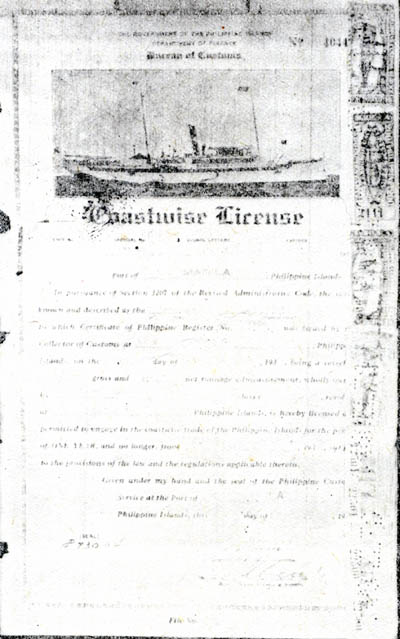Section
1415 of the Revised Administrative Code makes provision for the collection
of additional fees by affixing CUSTOMS DOCUMENTARY stamps to the documents
involved, as follows:
| "Section
1415. MISCELLANEOUS CHARGES. - When any article shall be sold
or service rendered by the Bureau of Customs in a matter if
for which a charge may be legally made, no fee therefor being
fixed by law, such charge shall be made as may from time to time
be prescribed by. regulation or order of the Insular Collector,
approved by the Department Head} and the payment of such charges
may be required to be made by the affixture and cancellation of documentary
stamps."
"Among
the charges which may be thus fixed are these: Pilot
fees, fees for the admeasurement of vessels, the fees
incident to the registration of copying of documents
in the exercise of the function of commercial register,
and such other charges as may but proper in connection. with the performance
of the duties pertaining to the office of
captain of port." |
In
accordance with the provisions of Section 1415, above quoted, Customs
Administrative Order No. 117, issued September 5,
1920, provided that the fees for admeasurement of vessels should
be collected "by the affixture to the certificate of the admeasurement
and cancellation thereon of Customs stamps
for the Sum of such fees". The admeasurement
fees established by this Order No. 117 ranged
from a minimum of P15.00 for vessels of twenty tons or less
to P187.50 for vessels of 1,500 tons, with an additional
fee of P0.50 for each ton in excess of 1,500. Fees for
the admeasurement of vessels were collected prior to the
issuance of Order No. 117, but stamps were not used as
the means of collection.
Examination
of Section 1414 of the Revised Administrative Code,
above quoted, indicates that the only fixed fees in excess
of P20.00 ($10.00 US) were those collected annually for the
license of each vessel engaged in the coastwise trade and for each
bay or river license. These fees were collected
prior to the approval of the Revised Administrative Code
in 1917, but it is believed that prior to October
1, 1917, stamps were not used as the means of collection,
since prior to that date CUSTOMS stamps were not issued
in denominations exceeding $10.00 (US Currency). The
annual stamp tax on the license to engage in the coastwise
trade exceeds one thousand pesos for the
larger steam and motor driven vessels,, Stamps to
the amount of the tax are affixed to the license.
It was for this main purpose that CUSTOMS DOCUMENTARY stamps
of denominations from P50.00 to P500.00 were issued in 1.917 and
were included in subsequent issues of these stamps.
See Figure Y.
Very
few of the denominations from 50 pesos to 500 pesos
are issued and used. Of the 200-pesos denomination of
the issue of 1917 a total of only 1,500 were issued.
This stamp was still current in November, 1940, no other
stamp of this denomination having been issued.
Less than 1,300 had been used up to the end
of 1939, indicating that the average
number of this denomination used each year is
less than sixty. Of the 500 pesos
denomination of 1917, a total of only 600
were printed. Of the 500 pesos
denomination of the issues of 1927-29, 200 were
printed in January, 1929. No more were issued
and the writer has seen only three specimens of
this stamp. These three specimens were preserved
by an employee of one of the shipping companies who was
also a stamp collector. Of the 500-pesos
denomination of the current 1930-32 issue,
total of 500 had been printed up to the end of
1939. The figures were obtained from the work-orders
for the printing of these stamps which are preserved
in the records of the Bureau of Printing Manila.

Figure Y
|


